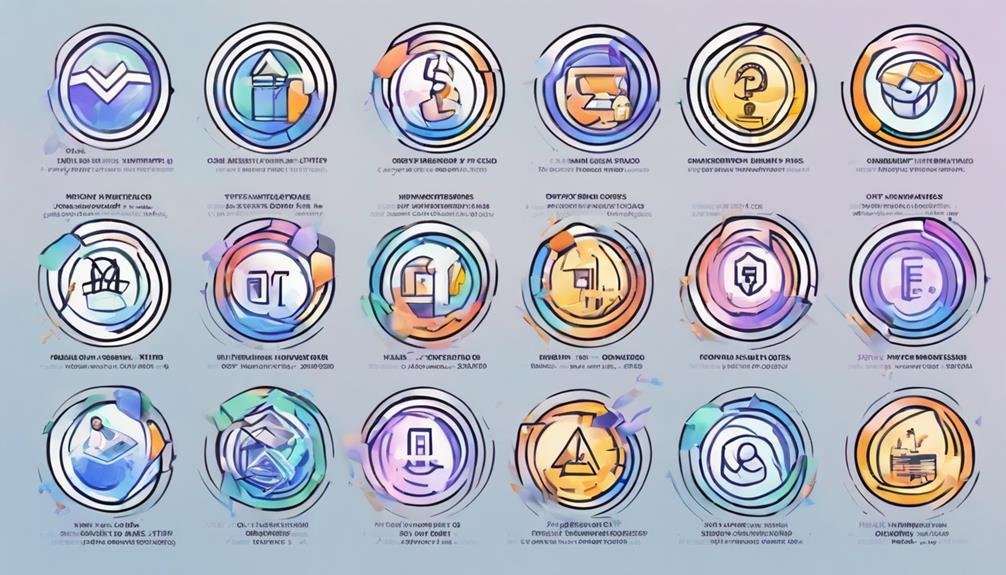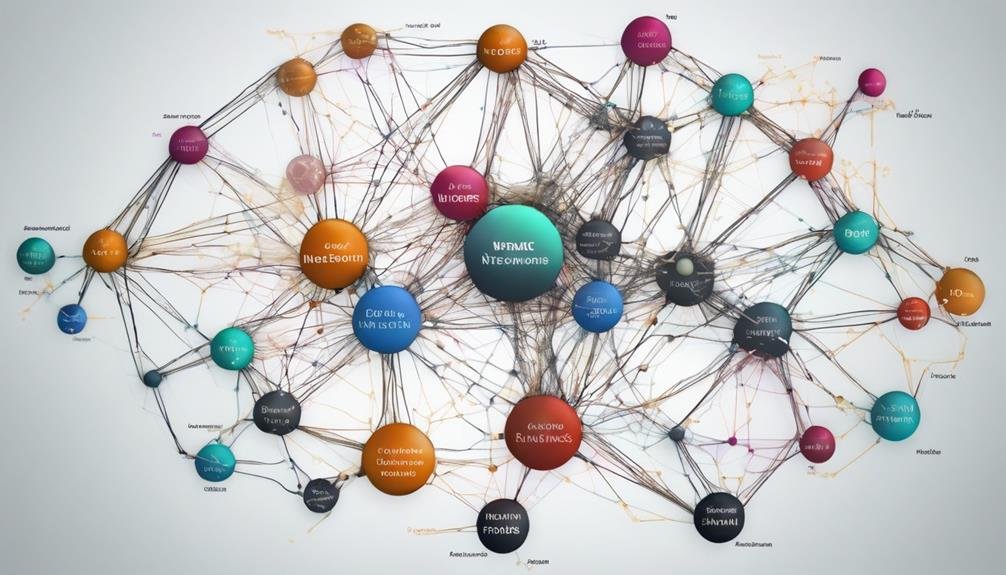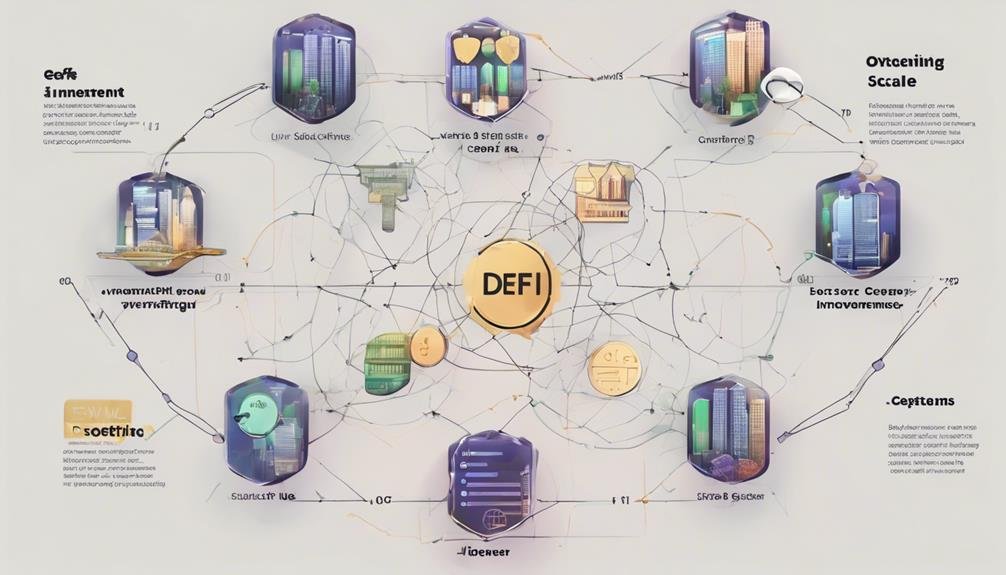Understanding tokenomics is essential in DeFi investments. Key aspects like token distribution, governance tokens, and supply-demand dynamics shape project evaluations. Governance tokens drive decisions in decentralized platforms, impacting value directly. A well-structured tokenomics model guarantees fair token distribution. Revenue metrics like transaction fees and yield farming incentives reflect profitability. Revenue streams affect token holder income distribution. Yield farming strategies use APY for profit assessment. Tokenomics influences revenue division. Ecosystem sustainability, community engagement, and legal compliance are important. Exploring these tips further will deepen your DeFi investment knowledge.
Table of Contents
Brief Overview of How Tokenomics Influences Defi Investment Decisions
- Understand tokenomics models for evaluating DeFi projects.
- Analyze revenue generation metrics like transaction fees.
- Consider profitability analysis methods for investment decisions.
- Implement effective yield farming strategies for optimal returns.
- Prioritize user-centric tokenomics for sustainable network effects.
Tokenomics Fundamentals
Tokenomics Fundamentals lay the groundwork for evaluating a project’s potential by defining key attributes that impact investor decisions. When considering a tokenomics model, factors such as token distribution, governance tokens, and the interplay of supply and demand come into play. The tokenomics model outlines the rules governing the creation, distribution, and overall management of tokens within a project. For DeFi projects, governance tokens are important as they often dictate decision-making processes within decentralized platforms.
Understanding the supply and demand dynamics is vital as they directly influence token value. A well-thought-out tokenomics model guarantees a fair and sustainable distribution of tokens, which can enhance investor trust and incentivize participation. By carefully analyzing these components, investors can gauge a project’s long-term viability and potential growth, ultimately making informed investment choices within the evolving landscape of decentralized finance.
Revenue Generation Metrics

Revenue generation metrics in DeFi projects provide valuable insights into the potential profitability of investing in tokens. By analyzing factors such as transaction fees and yield farming incentives, you can evaluate the income-generating capabilities of different DeFi assets. Understanding these metrics lets you decide which projects align with your profitability goals and investment strategies.
Profitability Analysis Methods
To evaluate the profitability of your DeFi investments, explore revenue generation metrics such as transaction fees, staking rewards, and token burns. By analyzing these aspects, you can assess the potential returns and risks associated with your investment decisions in decentralized finance. Understanding how tokenomics influences revenue distribution among token holders is pivotal in guiding investment choices.
Additionally, tracking revenue streams like lending interest, trading fees, and protocol usage fees can provide insights into the sustainability of revenue models within the DeFi ecosystem. It is essential to compare revenue generation mechanisms across different DeFi platforms to thoroughly understand potential ROI and associated risks, enabling you to make informed investment decisions based on solid profitability analysis methods.
Yield Farming Strategies
Considering the dynamic nature of DeFi investment strategies, exploring various yield farming tactics can profoundly impact your potential returns and risk management within the decentralized finance space. Yield farming involves earning rewards by providing liquidity to DeFi protocols, with APY being an important metric for profitability assessment. Strategies such as staking, lending, and liquidity mining significantly generate revenue through yield farming.
However, it’s crucial to be aware of impermanent loss and smart contract risks that can affect your returns. Active management is necessary in yield farming to optimize profits and mitigate risks effectively. Understanding decentralized governance, token distribution mechanisms, and the intricacies of smart contract risks is pivotal for successful yield farming endeavors.
User-Centric Tokenomics

User-centric tokenomics strongly emphasizes designing incentives that cater to the needs and behaviors of network participants. By focusing on the utility of the token and the benefits it provides to users, these strategies aim to foster active engagement and ownership within the ecosystem. The goal is to create sustainable networks that offer tangible rewards for user contributions, ultimately driving user activity and network growth.
Incentive Design Strategies
User engagement and loyalty within decentralized finance (DeFi) ecosystems are greatly influenced by incentive design strategies, particularly those focusing on aligning incentives to benefit network participants. In user-centric tokenomics, token rewards tied to user actions help drive desired behaviors and network growth, attracting and retaining a strong user base. By prioritizing user benefits, projects can foster sustainable network effects and paramount value creation.
These strategies play a pivotal role in shaping investment choices within DeFi, as users are more likely to participate in platforms that offer meaningful incentives for their contributions. Successful implementation of user-centric incentive design strategies enhances user experiences. It contributes to the overall success and growth of DeFi projects.
Token Utility Focus
Token utility in DeFi ecosystems revolves around enhancing participant engagement and experience through tangible benefits linked to token usage. User-centric tokenomics prioritize aligning user interests with network growth by offering added value to network participants. By providing access to exclusive platform features or discounts, tokens incentivize users to hold and utilize them, fostering a more active community.
This focus on token utility aims to improve user experience and create a more engaging environment within the ecosystem. Network participants are encouraged to participate actively in the platform, driving its success while reaping the benefits of their token holdings. Ultimately, user-centric tokenomics plays an essential role in shaping the interaction between users and the platform, enhancing the overall value proposition for participants.
Flywheel Effects in Networks

Embracing the concept of flywheel effects in decentralized networks reveals a pathway to sustainable growth and value creation. Token ownership drives increased network activity and boost the ecosystem’s value proposition. As users become token holders, they actively contribute to network growth and sustainability, aligning their incentives with the network’s success.
Participant-centric tokenomics empowers users to be co-owners, promoting long-term engagement and value creation within the network. Sustainable networks are characterized by robust flywheel effects, where the token’s value and the protocol’s usage reinforce each other for mutual benefit. By fostering a dynamic ecosystem where token holders actively participate and engage with the network, sustainable growth, and value creation are achieved, laying a solid foundation for the network’s longevity and success.
Sustainable Ecosystem Development

Sustainable ecosystem development in DeFi fosters long-term value for all participants involved. Decentralized governance guarantees the fair distribution of tokens and facilitates transparent governance and decision-making processes. Token models are designed to align incentives, benefiting stakeholders with a vested interest in the project’s success. Projects prioritizing sustainable ecosystem development set the foundation for long-term success by empowering users through participatory governance models.
By actively involving the community in decision-making, these projects guarantee that all participants have a say in the direction of the platform, thereby fostering a sense of ownership and commitment. Sustainable ecosystems in DeFi are built on the principle that the value of tokens is intricately linked to the growth of the ecosystem and the level of user engagement. This approach attracts investors looking for protocols with robust tokenomics that drive network value through active user contributions, ultimately leading to a more vibrant and sustainable ecosystem.
User Empowerment Systems

Empowering users in DeFi involves granting decision-making authority to token holders within the ecosystem. Decentralized governance systems rely on the voting power of these token holders to shape the platform’s future. Users can participate in important decisions such as fee structures, token issuance, and protocol upgrades by holding ownership of governance tokens. This decentralized decision-making process fosters community engagement and guarantees that the platform evolves in a manner that aligns with the collective interests of its users.
A user’s influence within the DeFi ecosystem is directly tied to their ownership of governance tokens. This user empowerment system establishes a framework where token holders must actively engage with the governance process to drive meaningful changes and steer the platform toward alignment with their preferences. Decentralized governance puts the power in the hands of the community, shaping the future of DeFi through collective decision-making.
Network Ownership Alignment

To guarantee a stake in the network’s success, network ownership alignment in tokenomics ensures that token holders benefit directly from growth and activity through incentives. By holding tokens, individuals become more than mere users; they become stakeholders with a vested interest in the network’s prosperity. This alignment fosters community and shared success as token holders see their investments grow alongside the network.
Moreover, governance rights granted to token holders empower them to participate in decision-making processes that shape the network’s future. This involvement not only enhances user engagement but also guarantees that the network evolves in a way that is beneficial for all stakeholders. Tokenomics design is vital in fostering long-term network sustainability, as token value becomes closely tied to user participation and network success. Aligned ownership models create a symbiotic relationship between users and the network, where each party’s interests are intertwined for mutual benefit.
Virtuous Cycles Creation

Creating virtuous cycles in tokenomics involves establishing positive feedback loops where token value and network usage mutually reinforce each other. As network activity increases, the token’s demand rises, boosting its value. This, in turn, attracts more users to participate in the ecosystem, leading to a self-reinforcing cycle of value creation. Here are three key elements that contribute to the creation of virtuous cycles in tokenomics:
- User Engagement: Strong community engagement drives the virtuous cycle by increasing participation and fostering network growth.
- Ecosystem Sustainability: The sustainability of the ecosystem is essential for maintaining the positive feedback loops that drive token value and user activity.
- Investor Confidence: Building trust and confidence among investors is critical for the long-term success of DeFi projects, as it guarantees continued support and investment in the ecosystem.
Establishing these factors not only enhances the ecosystem’s overall health but also solidifies investor confidence in the sustainability and growth potential of the project.
Long-Term Success Strategies

For long-term success in DeFi investment choices, understanding the tokenomics of projects is crucial. Evaluating the token emissions and distribution models is indispensable for guaranteeing sustainable investment growth. By identifying protocols with real value propositions for tokenholders, you can make strong investment decisions that pave the way for future success.
Opting for participant-centric tokenomics that offer tangible benefits drives network longevity and boosts user engagement, creating a thriving ecosystem. Building sustainable networks with robust flywheel effects ensures continuous value creation, providing a solid foundation for your investment portfolio. By focusing on projects prioritizing transparent and fair token distribution models, you can position yourself for long-term success in the dynamic world of DeFi. Make informed choices based on the tokenomics of each project to secure your investments and maximize your potential returns.
Legal Risk Reduction Techniques

How can robust legal frameworks effectively reduce regulatory risks in your DeFi investments? When maneuvering the complex landscape of decentralized finance, implementing strong legal structures is paramount to safeguarding your investments. Consider the following techniques to mitigate legal risks in your DeFi ventures:
- Compliance Measures: Guarantee adherence to AML and KYC regulations to uphold legal standards and prevent illicit activities within DeFi projects.
- Legal Counsel Engagement: Collaborate with legal experts to review smart contracts and token offerings, enhancing investor protection and legal certainty.
- Decentralized Governance: Embrace decentralized governance mechanisms to manage legal uncertainties and promote transparency within DeFi protocols.
Frequently Asked Questions
What Is Tokenomics in Defi?
Tokenomics in DeFi encompasses token distribution, economic models, governance structures, incentive mechanisms, market dynamics, and staking rewards. Understanding these factors is essential for evaluating investments in decentralized finance projects for long-term viability and performance.
Why Is Tokenomics Important When Investing in Cryptocurrency?
When investing in cryptocurrency, tokenomics is crucial. It’s like a compass guiding your decisions. Market dynamics, investor sentiment, economic incentives, governance models, token distribution, and price volatility all hinge on tokenomics for informed investment choices.
How Does Tokenomics Affect the Growth and Fall of a Defi Crypto Project?
Tokenomics impacts DeFi projects’ growth and falls through market dynamics, volatility, investor sentiment, liquidity pools, governance models, token utility, and distribution. Understanding these factors guides strategic decisions, influences speculation, and drives sustainable adoption.
What Is the Biggest Challenge About Defi?
Facing regulatory compliance, scalability issues, security risks, user adoption hurdles, liquidity concerns, and governance challenges, the biggest obstacle in DeFi emerges. How will you navigate these complex landscapes to guarantee success in this dynamic space?
Conclusion
To sum up, when evaluating your DeFi investment options, remember that tokenomics plays a pivotal role in the success of a project. From revenue generation metrics to sustainable ecosystem development, each aspect impacts the overall value of the token. By understanding the fundamentals and aligning your investments with long-term success strategies, you can navigate the intricate world of DeFi with confidence. So, next time you immerse yourself in tokenomics, choose wisely and watch your investments grow – or shrink.




